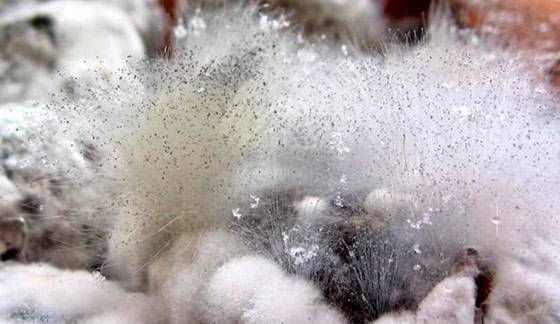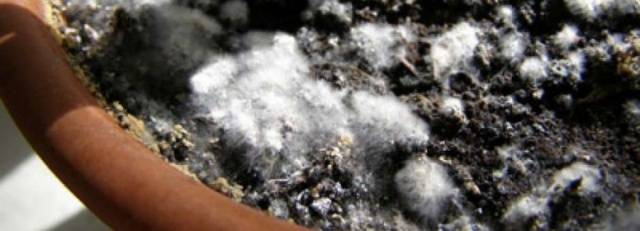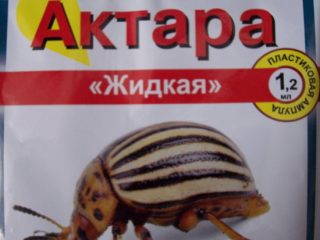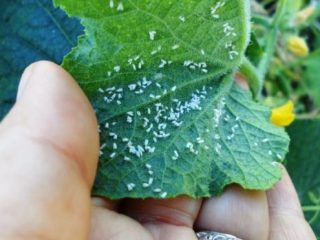Content
Anyone who at least once grows seedlings of vegetables or flowers may encounter this problem: a strange coating appears on the surface of the soil in the container in which the seedlings grow. If you look closely, it becomes clear that mold has settled there. This phenomenon raises many questions. What to do if mold appears in seedlings? Why does mold form on the ground with seedlings? Where did she come from? Is it harmful to plants and people? Let's try to answer them.
Mold - what is it
This is a microscopic fungus consisting of branching threads - hyphae. Most often, these fungi reproduce by spores. There are a lot of them in the air around us, they are in the soil and on various objects. Mold feeds on organic debris. The best conditions for its development are warmth and high humidity.
Mold is surprisingly resilient. It was found in space and on the walls of the nuclear reactor at Chernobyl. It is not afraid of frost, so freezing the soil does not rid it of fungal spores.It is extremely difficult to fight mold fungi; it is best to simply not create optimal conditions for them to exist and develop.
Why is it dangerous?
Penetrating into the human respiratory tract, it settles in the lungs. Accumulating in the body, mold causes various diseases, including allergies and toxic poisoning. Mold is especially dangerous for people with low immunity.
It negatively affects plants:
- mold is a fungus, after which more aggressive fungal races may appear, from which the roots of seedlings can rot, and blackleg disease is possible;
- plant nutrition is disrupted, mold waste products have an acidic reaction, and therefore change the acid-base balance of the soil for the worse for plants;
- oxygen does not reach them well;
- their immunity decreases and tissue regeneration deteriorates.
Mold is most dangerous for small seedlings that have not yet been picked. Adult seedlings have already mastered the entire volume of the pot well, their root system releases substances that suppress the growth of mold fungi, and the gardener will have to take care of the “babies”.
Seedling crops are grown indoors. It would seem that in a confined space nothing bad can happen to them, there is no contact with the street, and mold fungi simply have nowhere to come from. Why does the soil in seedlings become moldy?
Reasons for the appearance of mold in containers with seedlings
The source of fungal spores from which mold develops can be:
- the soil;
- mold that already exists in the room;
- seeds - they may also contain fungal spores.
The following factors contribute to its appearance:
- heavy soil structure in containers with seedlings;
- a large amount of undecomposed plant residues in the soil is the best food for mold fungi;
- high acidity of the soil, if the soil is neutral, the growth of mold fungi is suppressed by other microorganisms that are in the soil, but with increased acidity these mold fighters die;
- the soil in seedlings becomes moldy when there is an excessive amount of organic matter in the soil;
- poor drainage or lack thereof, in this case excess moisture is not removed through the holes, but evaporates from the soil surface, creating increased air humidity;
- the volume of the planting container is too large - the root system does not cover the entire soil, it turns sour near the walls of the pot, which contributes to the development of mold;
- rare ventilation and stagnation of air in the room;
- watering with unsettled water with a high content of mineral salts;
- too frequent and abundant irrigation of seedlings;
- absence of ultraviolet rays, window glass completely blocks them.
Mold is dangerous not only for seedlings. It happens that it appears on the surface of the soil before the seeds have sprouted. In this case, seedlings may not wait. Fungal hyphae are capable of germinating into sown seeds. The embryo will die and there will be no germination. Often, to speed up seed germination, containers with crops are covered with film. The microclimate underneath is simply ideal for the growth of mold fungi. If there are spores there, they will definitely germinate, and the gardener will observe mold on the soil when growing seedlings.
The color of mold depends on the type of fungus. A white fluffy coating most often appears in planting containers.If white mold appears on the ground with seedlings, it is a fungus from the genus Mucor. It usually lives in the surface layers of the soil. Mucor can also be observed on foods, for example, on spoiled bread. Mucor food is biological remains, of which there are many in insufficiently decomposed soil.
If white mold appears on seedlings, what should you do? First of all, it is necessary to increase the temperature where the seedlings are growing. Mucor does best in cool conditions.
Mold in pots with seedlings can be a different color: green or even black. The latter is especially dangerous for both humans and domestic animals, which can also suffer from it. If brown mold appears on the soil of seedlings, measures must be taken immediately. How to deal with green mold in seedlings? In the same ways as with its other types. The main thing is to do it quickly. Every day the hyphae of the fungus grow and harm plants more and more.
If the soil with seedlings is moldy, what should you do in this case? How to deal with mold on seedlings?
How to deal with mold plaque
It needs to be dealt with comprehensively. And first of all, you should analyze the conditions of keeping the seedlings, understand what was done incorrectly. You can always change the irrigation regime, if necessary, increase the temperature where the seedlings are kept, reduce air humidity, and make drainage holes in the planting container if there are none.
It is much more difficult to fight mold on seedlings if the cause of its appearance is incorrectly selected soil.
To destroy mold that appears on the ground when growing seedlings, several methods are used.
- Mechanical.
- Chemical.
- Biological.
- People's
First of all, they begin with mechanical removal of mold deposits from the soil in the container or pot in which the seedlings are grown.
How to remove mold from seedlings mechanically:
The procedure is carried out very carefully.
- Using a flat spatula, preferably a wooden one, or a toothpick, remove the layer of soil on which mold is visible.
- Add new soil instead of the removed part of the soil, otherwise the bare roots will suffer and may die.
- Dry the soil well, preferably under the bright rays of the sun. New soil must be thoroughly disinfected so as not to introduce a new portion of fungal spores with it.
- All collected soil must be removed from the apartment so that it does not become a source of mold spores.
It must be remembered that this method is a temporary measure. Its use only stops the development of mold fungi. If they have already settled in a pot or container, then over time they will appear again and again. But by then the seedlings will have grown up and will be able to fight fungi on their own.
You can further protect the top of the soil in the following ways:
- dry soil is sprinkled with wood ash, a fairly thin layer, the benefits of this are double - the ash absorbs moisture well and reduces the acidity of the soil, and fungi really don’t like this;
- You can sprinkle the soil with well-washed and disinfected dry river sand; it is unattractive to fungi.
If the mechanical method does not produce results and the mold appears again, do not start all over again. We need to proceed to the next stage and use chemicals against it. Experienced gardeners recommend using Oksikhom and Fundazol for processing. Solutions of these drugs are used instead of irrigation water, usually once. You can do it another way:
- remove plants affected by mold and treat the soil with copper sulfate of 3% concentration;
- spray the soil and diseased seedlings with solutions of antifungal fungicides, for example, Quadris, Tsikhom.
If you do not want to use chemicals in your apartment, you can use biological agents.
Experienced gardeners recommend the following biological preparations to combat mold in seedlings: Fitosporin-M, Alirin-B, Gamair-SP, Planriz-Zh. They treat seedlings on the 8-10th day of their life. One or even double treatment will not give results. After the first application, it is repeated every 5 days three more times. Along with spraying, the soil is watered with a biofungicide solution, which is prepared strictly according to the instructions.
There are also traditional ways to combat mold on seedlings. What do gardeners use if the soil for seedlings is covered with mold:
- Once every 2 weeks, water the seedlings with a pink solution of potassium permanganate.
- Activated carbon tablets are crushed and buried in the upper layers of the soil. Charcoal can be used against mold on seedlings in another way: sprinkle crushed charcoal on the surface of the soil. Sometimes crushed charcoal is mixed with sifted ash obtained from burning hardwood. Proportion – 1:2.
- When preparing a mixture for sowing seedlings, Shungi Terra fertilizer is added to it. You can dust the surface of the soil with it. Shungite, which is part of the fertilizer, is an effective remedy for all fungal infections.
- You can spray the soil with a weak solution of Miramistin.
- Nystatin against mold on seedlings is also a good solution. The tablet is turned into powder and lightly sprinkled on the surface of the soil.
- Metronidazole against mold on seedlings is used in the form of a solution: one tablet per two and a half liters of water.
- Spraying seedlings with Nitrofungin solution helps well - dilute 25 drops in 0.5 liters of water.
Why mold can occur on seedlings and how to deal with it - all this is explained in the video:
What to do if peat pots with seedlings become moldy
Many gardeners have already abandoned the use of peat pots for growing seedlings. As practice shows, they very often become covered with mold. A radical way is to transplant the plant into new soil and into a new container. If this is not possible, you can coat the outside of the pot with Fitosporin-M paste, and treat the soil for prevention using any of the methods suggested above.
How to remove mold from petunia seedlings or mold from strawberry seedlings? One of the above methods is suitable for this. These plants develop slowly at first, so they require special attention.It is better not to wait for mold to appear, but to properly care for the seedlings and carry out preventive treatments.
Why do peat tablets with seedlings mold? If watering the plants is moderate and all other care measures are carried out correctly, this indicates that the peat that was used to prepare the tablets has not been aged enough and has an acidic reaction. In this case, it is better not to wait for the plant to die, but to replant it in new soil.
Conclusion
Any mold that appears in the soil with seedlings must be combated. In this way, we will not only protect the planted plants from death, but also preserve our own health, which can be seriously damaged by mold.



















V posadochnom grunte dlja rassadi tomatov Multiflora 250 ltr. pojavilasj belaja plesenj. Kak mne obezvreditj grunt.Kakuju proceduru i chem neobhodimo provesti dlja etogo?